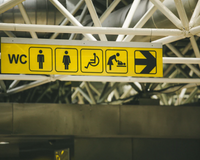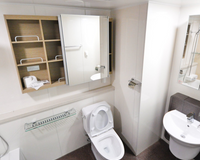Managing restroom hygiene in high-traffic public venues is no small task. Whether you oversee a stadium, shopping mall, airport, or other busy facility, restroom cleanliness can leave a lasting impression on visitors. A clean, well-maintained restroom not only enhances visitor satisfaction but also promotes health and safety. This guide dives into practical steps you can take to ensure the restrooms in high-traffic areas are hygienic, organized, and welcoming for all users.
Understanding Common Challenges in High-Traffic Restrooms
High-traffic restrooms face the following unique challenges due to the constant influx of users they see throughout the day.
- Difficulty maintaining consistent cleanliness and sanitation: Overflowing trash bins and wet floors pose slip and fall hazards as well as cleanliness issues.
- Depleted supplies such as soap and paper towels can quickly lead to an unappealing and unsanitary environment.
- High usage increases the risk of damage to fixtures like sinks, stalls, or hand dryers, which may require frequent inspections and repairs to remain operational and safe for users.
- Managing odor control with proper ventilation: With hundreds or even thousands of people using the facilities daily, poor air circulation can lead to unpleasant smells, impacting visitors' overall experience.
- Accessibility requirements for diverse users, including individuals with disabilities and families with small children, require planning and proper resource allocation.
Addressing these challenges requires both preventative measures and a responsive maintenance protocol to keep restrooms in optimal condition at all times.
Clean Restrooms Frequently
Frequent cleaning is the foundation of maintaining hygienic restrooms. High-traffic public venues such as airports or transportation hubs see hundreds, if not thousands, of visitors every day. This increases the chances of restroom surfaces quickly becoming unsanitary. The following tips can help keep these facilities in good working order:
- Develop a cleaning schedule: Create a detailed cleaning schedule outlining specific tasks, such as wiping down sinks, disinfecting toilet seats, and mopping floors. Ensure these tasks are carried out multiple times per day, especially during peak hours.
- Track cleaning tasks: Utilize a checklist or a digital tracking system for maintenance staff. Not only does this hold staff accountable, but it also ensures consistency in cleaning procedures.
Regular cleaning reduces the spread of germs and provides guests with a restroom environment they feel comfortable using.
Ensure Proper Ventilation
Ventilation is key to maintaining a restroom that looks, feels, and smells clean. Poor air circulation can trap odors and increase humidity levels, which may lead to mold and the spread of airborne germs.
Installing efficient ventilation systems and completing regular maintenance will help ensure optimal performance. These systems effectively minimize odors and regulate humidity. You can also add automatic air fresheners or deodorizers to complement the ventilation system. However, proper airflow should remain the priority.
Effective ventilation contributes to a fresh and pleasant atmosphere, enhancing the experience for restroom users while limiting potential health risks.

Invest in Touch-Free Fixtures
Minimizing germ transmission is critical in high-traffic environments, and touch-free fixtures make achieving this much easier.
A great way to limit contamination is by installing touch-free faucets, soap dispensers, hand dryers, and toilet flush systems. These fixtures not only improve hygiene but also add a modern and sleek look to the restroom.
Touch-free fixtures also prevent the wear and tear caused by constant handling, making them a long-term investment in restroom usability and cleanliness.
By incorporating touch-free technology, you can elevate hygiene standards and reduce cross-contamination.
Keep Supplies Well-Stocked
Empty product dispensers and missing essentials such as toilet paper and hand soap can tarnish the restroom experience and lead to complaints from visitors.
- Inspect supplies regularly: Regularly check and refill soap, paper towels, and toilet paper supplies. Consider higher-capacity dispensers for venues with extremely high foot traffic to reduce the frequency of refills.
- Offer additional hygiene items: Another way to improve hygiene is to install commercial toilet seat cover dispensers for an added layer of hygiene for guests. Make sure the dispensers are installed according to ADA requirements to ensure all visitors have the option to use them.
- Pay attention to small details: Ensure stalls also feature sanitary disposal bins and liners for menstrual product disposal, particularly in women’s and all-gender restrooms.
Fully stocked restrooms prevent frustration and create a more seamless, positive experience for users.
Provide Adequate Trash Bins
Trash bins might seem like a simple aspect of restroom design, but strategically placed and routinely emptied bins play a vital role in cleanliness.
- Strategic placement: Position trash bins near exits, handwashing stations, and within stalls where menstrual product disposal is necessary. This encourages proper waste disposal and keeps litter off the floor and out of the plumbing system.
- Regular emptying: Establish frequent bin-emptying schedules to prevent overflows. Overflowing bins are not only unsightly but can also lead to unpleasant odors.
Well-placed and frequently emptied bins are an easy way to promote a clean and hygienic facility.
Use High-Quality Cleaning Products
Not all cleaning solutions are created equal, and using subpar products can leave germs and allergens lingering.
Invest in high-quality disinfectants that eliminate bacteria, viruses, and mold without damaging surfaces. You can also use odor-neutralizing products for enhanced freshness and opt for eco-friendly products to minimize the environmental impact of cleaning processes.
High-quality cleaning products ensure your facility remains germ-free and welcoming while upholding a professional standard.
Perform Regular Facility Inspections
Routine inspections allow you to identify and address potential restroom issues before they escalate.
- Plan for visual walkthroughs: Include restroom inspections in your daily maintenance routine. Look for leaks, clogs, or broken fixtures that could compromise cleanliness or usability.
- Prioritize preventive maintenance: Proactively repair faulty fixtures to minimize downtime, prevent leaks, and avoid inconveniencing guests.
Routine inspections maintain your restroom’s functionality and ensure it consistently meets high standards.

Provide Comprehensive Training for Cleaning Staff
Even the best hygiene practices fail without a well-trained team carrying them out. That’s why it’s important to educate staff on cleaning techniques, proper handling of cleaning products, and hygiene protocols. Include specific instructions for touch-free technology and the use of digital checklists.
Encourage open communication so that your staff feels comfortable reporting challenges or suggesting improvements. Equipping your team with the right tools and training empowers them to excel in maintaining cleanliness.
Display Handwashing Reminders for Visitors
Promote good hygiene among restroom users with visible signage.
- Handwashing guides: Place clear, eye-level signs near sinks instructing users on proper handwashing techniques to prevent the spread of germs.
- Disposal reminders: Include signage within stalls to remind users of proper waste disposal methods, including instructions for disposing of menstrual care products safely.
Signage enhances visitor awareness and contributes to a culture of cleanliness within your facility.
Restroom Hygiene Is Key to Public Health and Safety
Managing restroom hygiene in high-traffic public venues is a crucial responsibility for ensuring positive guest experiences. By prioritizing frequent cleaning and monitoring restock and staff training efforts, facility managers can maintain restrooms that leave a lasting impact for all the right reasons. Whether dealing with ventilation, maintenance inspections, or signage, every detail contributes to an efficient and hygienic facility.
If it’s time to upgrade your commercial bathroom fixtures, Choice Builder Solutions can help. Browse our selection of high-quality fixtures today and reach out if you have any questions.





